Any individual or organization that is concerned with transporting cattle must adhere to a variety of laws and regulations. In a bid to improve animal welfare, there have been numerous guidelines introduced in relation to the transportation of livestock. Despite the strict regulatory framework, there are specialist logistics firms who deal with transporting cattle. When companies, farmers or food producers need to move livestock from one location to another, specialist transportation services can be arranged.
Before you can transport livestock, it’s important to identify the relevant legislation and regulations which apply. There are numerous government organizations that are involved in regulating transporting cattle and other animals. The United States Department of Agriculture (USDA) has issued a number of regulations which apply to transporting cattle and other animals, for example.
Introduced in 1966, the Animal Welfare Act regulates the treatment of animals in various environments, including transportation. As the only federal law that is concerned with animal welfare during transportation, it is the primary source of regulation for transporting cattle.
Although the original Animal Welfare Act was passed in 1966, it has been subject to various amendments throughout the years. In order to adhere to the current legislation, you will need to examine the latest amendments to the Act.
While the Act itself remains the legitimate source of law, there are various publications which can be used to help to understand the legal framework. As legislation can often be difficult to interpret, additional resources, such as the USDA NAL Animal Welfare Quick Reference Guides published by the Animal Welfare Information Center, can be helpful in deciphering the details of the Act.
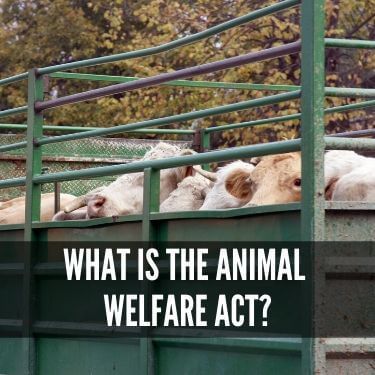
The Animal Welfare Act covers a number of areas which relate to transporting cattle and other animals, including:
In addition to the Animal Welfare Act, the Animal Welfare Regulations provide further standards that must be adhered to when transporting cattle and other animals. These include, but are not limited to:
Before transporting cattle, you will need to obtain a Certificate of Veterinary Inspection (CVI). Sometimes known as a health certificate, this confirms that the animals have been examined by an accredited veterinarian and found to satisfy the relevant regulations. A Certificate of Veterinary Inspection can only be issued by a State, Federal or Tribal accredited veterinary.
As there are varying requirements for transporting cattle and other animals based on the departure location, destination and distance of travel, the type of inspection carried out may vary depending on the intended form, mode, and route of transportation. Due to this, further certification may be required if the proposed route, destination or mode of transport is altered prior to departure or partway through the journey.
The transport of animals is a complex process, so advanced planning is always required. As many of the requirements for transporting cattle need to take place well before their journey begins, the preparation process should typically start weeks before you intend to transport cattle.
First, you will need to assess the requirements under the Animal Welfare Act and ensure that your proposed route and method of travel does not contravene any relevant legislation or regulations.
The regulatory timeline is a critical guide to preparing cattle for transportation and should be followed carefully. If you do not yet have an appropriate license, for example, you will need to make an application, and have it approved well before you intend to begin transporting cattle.
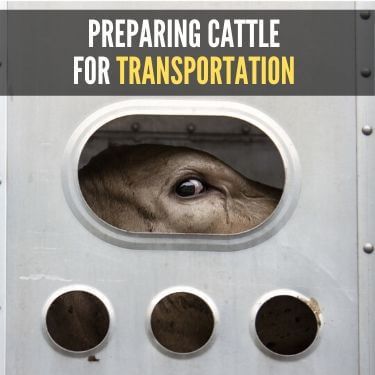
It’s important to identify any particular requirements the intended destination sets out, as this could vary from journey to journey. Many countries, states, and jurisdictions have different protocols, and vaccinations may need to take place at least three months before transportation occurs.
If you plan on moving cattle or any livestock animals interstate, the United States Animal Health Association (USAHA) and the National Institute for Animal Agriculture (NIAA) host a useful interstate livestock website. This enables you to find out what state import regulations apply to moving cattle across state lines, depending on your specific departure location and intended destination.
Once you know exactly what the requirements for the journey are, you can begin to undergo the appropriate preparation. If the destination requires cattle to receive vaccinations in advance and in a particular order, for example, this protocol can be followed prior to the intended date of departure.
Similarly, veterinary inspections can take place in a timely manner so that a Certificate of Veterinary Inspection can be used prior to beginning the transportation process. Moving cattle and livestock animals can seem overwhelming at first, particularly if you have limited experience in this area. By seeking advice from specialist livestock transporters, however, you can plan an appropriate route, prepare the animals in advance and ensure that you meet all relevant regulatory requirements.
Before loading cattle into a livestock trailer, it’s important to carry out a number of checks on the vehicle. These include:
If you regularly work with livestock animals, you will know how tricky it can be to move them from one location to another. Encouraging cattle to board a trailer can be particularly troublesome but there are some tips you can employ to make the process easier. For example:
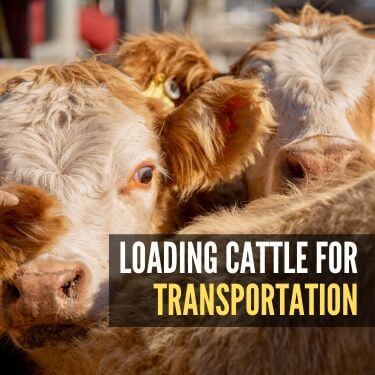
When loading and transporting cattle, it’s also important to consider the time of day and the temperature. In hot conditions, temperatures are highest between the hours of 11 a.m and 4 p.m., for example, so loading and unloading during this timeframe should be avoided, if possible.
The maximum legal load limit varies from state to state, it’s essential to consider this when planning your journey. Whilst you will need to adhere to a maximum load limit, you will also need to balance the load appropriately to maintain safe transportation conditions. This will affect the loading process and should be thoroughly planned in advance.
If you're shipping cattle, it's likely that you may also need to transport cattle feed at some point. For more information on how to do this, check out our article Shipping Bulk Cattle Feed.
Under Section 2141 of the Animal Welfare Act, all animals must be marked or identified before transportation takes place. If you are planning on moving cattle or livestock animals, it is important to assess which identification strategy you wish to use in advance.
Many cattle identification strategies involve the use of numbers and/or letters to identify information about the herd. To ensure accurate identification is possible at all times, the following cattle identification methods may be used:
Although nose printing can also be used as a method of identifying individual cattle, the complexities and time-consuming nature of this type of identification prevent it from being used to facilitate large scale cattle transportation.
Ideally, markings should be easy to apply, permanent and easy to read from a distance. As there is no one form of marking that meets all these criteria, most herd owners use at least two different types of identification, such as ear tags and tattoos.
To ensure accurate identification can be made at all times, an established cattle identification strategy should be used. There are various different types of identification strategies which can be implemented, such as:
Strategy 1
Each animal is designated a unique three or four-digit number. The first number indicates the year of their birth within the current decade. The remaining two or three numbers represent the animal’s individual number, which is often assigned based on which animal was born first. For example, if a has the identification number 3024, the 3 represents its birth year within the decade (2013), whilst 024 is the cow’s individual number. In this example, 3024 indicates that the cow was the 24 calf to be born in 2013.
Strategy 2
This second strategy is commonly used with Brahman-based breeds and also uses numbering to facilitate identification. In this instance, the year of the animal’s individual number is written above their birth year. Alternatively, a dash may be used to separate these two numbers.
Strategy 3
Often used to identify European and British cattle breeds, strategy three involves using a letter to represent the animal’s year of birth, followed by the cow’s individual number. Each year is assigned a letter, although the letters I, O, Q and Z are not routinely used at all. The letter representing the animal’s year of birth may be placed either before or after their individual number, so an identification mark may be written as Y024 or 024Y.
Strategy 4
This final numerical strategy simply involves numbering each member of the herd consecutively. If a herd consists of 250 cows, for example, and three calves are born, these would be assigned the numbers 251, 252 and 253. Although this is a simple and straightforward way of marking cattle, it does mean that the cow’s year of birth cannot immediately be ascertained by looking at their markings.
When moving cattle, the number of cows which can be transported will depend on the size of the truck. As well as adhering to strict legal loading limits, transporters must ensure that the size of the truck enables the cattle to be moved safely and humanely.
In general, however, you can gauge how many cows a cattle truck can hold by assessing the size of the truck and the weight of the cattle. In a 16 ft. x 6ft. cattle trailer, for example, the total weight should be less than 7,400 lbs. If you are moving cattle with an average weight of 400 lbs., you would be able to transport 18 cows in this environment. Alternatively, the same trailer could move five larger cows weighing approx. 1,600 lbs.
In contrast, a 32 ft. x 7ft. cattle trailer could carry a total weight of up to 17,300 lbs. For cattle with an average weight of 400 lbs., 43 cows could be transported. Alternatively, 11 cows with an average weight of 1,600 lbs. could be moved.
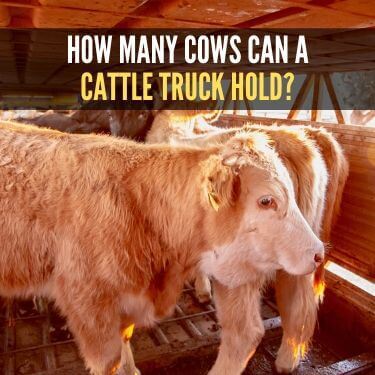
Although the weight of the animals and the size of the truck gives you a general idea of how many cows a trailer can hold, there are other factors to consider. Whenever you are transporting heavy cargo, it’s essential that the weight is distributed effectively. This can help to increase road safety and minimize the risk of accidents.
When transporting cattle, you will need to adopt a similar approach to weight distribution. A livestock trailer may have a total weight limit of 17,300lbs, for example, but you will find that this is split into compartments. Each compartment will have its own weight limit, depending on its size and location within the trailer. In order to ensure animals can be moved safely, transporters should adhere to these loading limits at all times.
Moving cattle can be inherently stressful for the animals, so it’s vital that the process is carried out as calmly and as comfortably as possible. Under the strict regulations for transporting livestock animals, excess stress could constitute inhumane conditions, which would result in serious consequences for the transporter.
Ensuring that stress is reduced helps to ensure that livestock animals are transported from one location to another humanely and in accordance with the relevant laws and regulations.
However, there are additional advantages to planning a stress-free journey when transporting cattle. When cattle are moved, ‘shrink’ may occur. Shrink refers to weight loss which occurs due to a range of factors, but it is commonly associated with the stress of being transported.
As shrink causes a cow’s weight to drop, this can be disadvantageous to owners and sellers. Whilst experienced owners will expect some shrinkage to occur throughout the journey, an excessive amount of shrink could be indicative of traveling conditions which are too stressful for the animals.
Due to this, herd owners will monitor shrink carefully and may switch to an alternative livestock freight carrier if excessive shrink occurs on a regular basis. As well as potentially affecting the value of their herd, repeated excess shrink could imply that the traveling conditions are too stressful for the animals.
The temperature is a key factor when transporting cattle, as excess heat or cold can contribute to stress. Due to this, internal and external temperatures should be consistently monitored and recorded. Furthermore, transporting cattle in excessive temperatures should be avoided wherever possible.
The loading and unloading process can be particularly stressful for cattle, so it’s important to approach this slowly and calmly. Experienced handlers and transporters will always factor in extra time to facilitate the calm loading and unloading of livestock animals.
In addition to this, thirst, hunger, fatigue, and injury throughout the journey can contribute to increased stress levels. By planning journeys in advance, providing feeding and drinking facilities, limiting journey times and preventing injury, transporters can help to minimize stress and promote animal welfare whilst moving cattle.
If you're brand new to the world of shipping freight, take a look at our article A Beginner's Guide to Freight Shipping.
There are various regulations associated with the transport of animals and these include strict time limits on how long they can be transported for. When using livestock transport to move cattle, for example, you will only be able to transport the cows for a specific amount of time.
Livestock animals, including cattle, can be on a truck for up to 28 hours before they must be unloaded. However, this 28-hour period includes the time it takes to load and unload the animals. As this can be a time-consuming process, cattle may spend significantly less than 28 hours actually on the road at one time.
Although drivers of cattle trucks have been exempt from the Electronic Logging Device (ELD) Rule if they stay within a specific distance of their origin, consideration must also be given to maximum driving limits. Due to strict regulations regarding how long drivers can remain on the road and how long they are required to rest, this can result in livestock transport effectively being delayed.
If a driver has to take a 10-hour rest after 11 hours of driving, for example, they would be forced to unload the cattle after every 11-hour driving period, which increases stress for the animals. However, using two drivers on longer routes can help to avoid this issue.
Once the 28-hour time limit has been reached, livestock animals must be unloaded off of the truck, provided with water and food, and given at least five hours rest. As suitable facilities will need to be used to break up longer journeys, it’s vital that these are planned in advance. Furthermore, contingency plans should always be in place in case a journey ends up being longer than intended. If traffic conditions increase travel time, for example, an unforeseen break may need to be taken so that the 28-hour limit isn’t breached.
Although there are general regulations that apply to livestock transport, there are more detailed rules regarding specific animals and breeds. In addition, there may be additional guidelines pertaining to the movement of particular types of animals.
For example, different processes may be used when transporting dairy and beef cattle. Similarly, extra precautions should be taken when moving calves. As their immune systems are not as well-developed, it’s essential that stringent hygiene practices are enforced when transporting calves.
In addition, subsequent vaccinations and scheduled veterinary practices should be left until at least one week after the journey has been completed. As both transporting calves and carrying out veterinary processes increases the calves’ stress, separating these two procedures can help to reduce their overall stress levels.
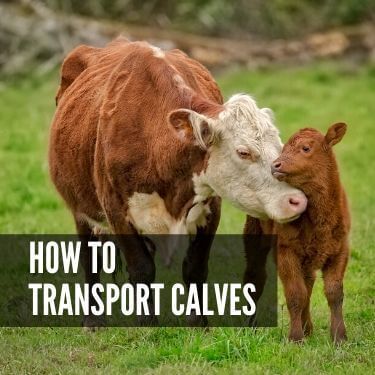
Furthermore, the space allocated to each calf may be bigger than to an adult cow, in relation to its size. This is because calves will tire more quickly and may need additional space to be able to lie down whilst they are being transported. As calves are unable to regulate their body temperatures less well than older livestock, extra consideration must be given to temperatures inside and outside the livestock trailer.
Although the ’28-hour’ transportation rule applies to cattle, this is not routinely followed when transporting calves. As these animals become dehydrated more quickly than older cattle, transporting them for a full 28-hour period is likely to result in increased stress and discomfort for the animal.
As each state has its own regulations regarding the import and export of livestock, extra precautions will need to be taken if you plan on transporting cattle across state lines. While the regulations may not be as strict as importing and exporting from outside the U.S., there are still various protocols that must be followed. Of course, this doesn’t not render the federal law and regulations redundant. Rather, transporters must ensure that livestock transport meets both federal and state regulations.
Before planning livestock transportation, it’s important to identify the specific requirements issued by the departure state and the destination state. As every state is free to implement its own regulations, different protocols may be required every time you transport cattle.
Furthermore, experienced livestock freight handlers have an in-depth knowledge of the laws regarding interstate cattle transportation. By seeking advice from a reputable transport and logistics company, you can ensure that your cattle can be transported safely, humanely and in accordance with the relevant state and federal regulations.
Weather extremes can have a damaging effect on cattle, so it’s important to monitor the temperature at all times. As well as recording the external temperature, the temperature inside the livestock trailer should be carefully monitored too. Even when temperatures are not startlingly low, the associated wind chill can be. Due to this, transporters should have a good understanding of how to keep cattle warm in cold environments.
As well as laying down extra straw to increase insulation, wet bedding should be changed frequently to prevent it from freezing. Overcrowded should always be avoided but it’s particularly important in cold weather, as the inability to move freely can cause frostbite to develop. Providing adequate ventilation is facilitated, the bottom ventilation slats in the livestock trailer may be closed to prevent spray from the road hitting the cattle.
The breed of cattle and their coat can also have an impact on how well they respond to cold weather. A critical temperature for beef cattle with a summer coat is typically around 59°F but this drops to 18°F when they are protected by their heavy winter coat.
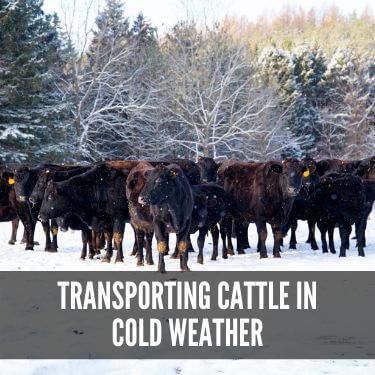
If transporting cattle in cold weather cannot be avoided, transporters should be sure to monitor livestock for signs of excess stress or coldness throughout the journey. As exposure to low temperatures can cause serious health problems, transporters should ensure their contingency plans factor in a solution for complications arising from exposure to cold environments. Also, expedited freight service should be used whenever available during extreme cold. Getting cattle to their destination quickly is extremely important when dealing with harsh climate.
There are a variety of reasons why cattle or livestock may be deemed unfit for travel. These include:
If cattle are unfit for transport, transporters must not attempt to move them. Instead, they must remain in appropriate housing until they are fit to travel or until alternative arrangements have been made. If an animal is unfit for transport because they are suffering from a minor illness, for example, they may be certified as fit to travel by a veterinarian when they have received treatment and recovered.
With over 1 million head of cattle in New York, it’s not surprising that there is such a high demand for cattle transportation services. A significant number of dairy and beef farms are located in the majority of countries in NY, and all of them require livestock transport at some time or another.
Due to its prime location, New York has excellent transport links, particularly when it comes to the transport of animals. As well as extensive road and rail links, the state also has port facilities which can cater for the transportation of animals via the sea. While livestock transport via air remains a controversial topic, the range of airports within New York ensures that herd owners and farmers can utilize these transport options, if they choose to.
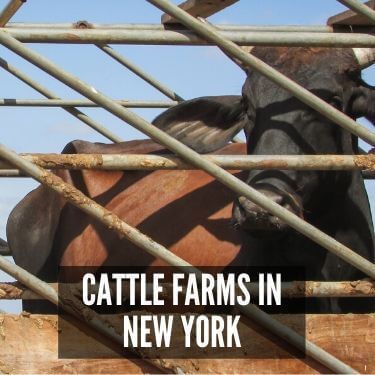
There are over 5,500 dairy farms in New York State, with a total of approximately 625,000 dairy cows. When these cows are no longer able to produce an adequate amount of milk, they are typically retired and transported to slaughterhouses to be used in the food industry. Alternatively, farmers may choose to transport them to pasture.
As a thriving industry, a significant number of dairy cows in New York enter retirement every year, which means there is a continual demand for livestock transport services. Whether farmers choose to transport cattle to nearby slaughterhouses or across state lines, specialist freight services will ensure the animals are transported safely and humanely.
Regardless of what type of cattle you're shipping from New York, our new york freight shipping services provide you with everything you need to safely and quickly transport your cattle.
Farmers and herd owners must factor in the cost of transport when determining whether to move cattle or where to move them too. There are various elements that can affect the cost of shipping cattle from one location to another, so it’s vital that detailed analysis takes place.
The size and breed of the cattle will affect how many cows constitute a full load, so this obviously has an impact on the ‘per head’ transport costs. Furthermore, the size of the livestock trailer will determine whether cattle can be moved in one truck or whether numerous vehicles are needed. Using one larger vehicle to facilitate the transportation of all cattle may be cost-effective than using numerous trucks to transport a few cattle at a time.
Of course, the distance of the proposed journey will also play a significant role in determining the cost of transporting cattle. As well as the increased mileage, anything which takes the transporter over the 28-hour limit will automatically mean that an additional five hours must be given for the cattle to rest. Furthermore, the distance will determine how often the driver will be forced to stop and take a rest, which can extend the journey further.
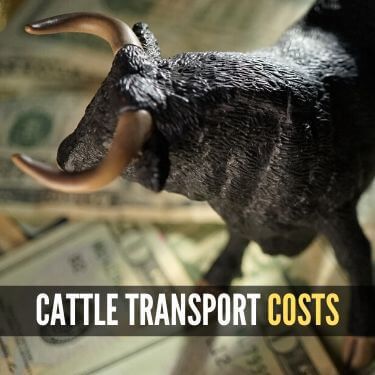
Freight insurance is another factor that needs to be considered. All freight shipments are covered by standard carrier liability, but this only covers a fraction of the total value of your shipment. The value of your cattle shipment can be quite high, especially when shipping large volumes. For this reason, purchasing additional insurance, either directly from a carrier or third-party provider, is highly recommended.
However, there are a number of innovative solutions that can reduce travel times and minimize costs when it comes to transporting cattle, livestock and other animals. By working with experienced carriers and transporters, farmers and herd owners can benefit from low transport rates, enhanced conditions and efficient delivery times.
When obtaining freight quotes, ask about any accessorial charges that you may be charged. Take a look at our article Truckload Accessorial Charges Defined and Explained to learn more.
If you need to move cattle throughout the U.S. or internationally, R+L Global Logistics can provide the specialist service you require. With extensive experience in the logistics industry, we offer a wide range of niche transport options including livestock travel.
Our experienced in-house team can provide detailed advice regarding the regulatory requirements of moving cattle and ensure that you have the documentation required before the journey begins. Furthermore, our drivers and transport teams are adept at moving cattle and livestock safely, humanely and efficiently. With a range of advanced equipment and a state-of-the-art fleet, we’re committed to providing the best transport solutions for animals and livestock.
When you're ready to transport your cattle, give us a call at (866) 353-7178 or click "Freight Quote" below to receive a customized freight quote from one of our transportation experts.
R+L Global Logistics
315 NE 14th St., Ocala, FL 34470